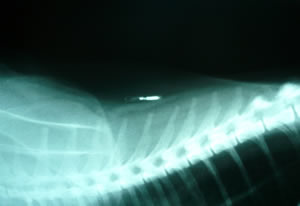
Microchipping is a simple, safe and quick procedure which helps to reunite dogs with their owners.
A microchip implant is a tiny integrated circuit placed painlessly under the skin of an animal. The chip, about the size of a large grain of rice, uses passive RFID (Radio Frequency Identification) technology and can be easily read by vets and animal sanctuaries to read data about a pets owner.
Legislation introduced in April 2016, states that it is compulsory all for owners to ensure their dog is microchipped by 8 weeks of age and their contact details stored and kept up to date in a DEFRA compliant, pet microchipping database. If they do not, they could face a fine of up to £500.
The Microchipping of Cats and Dogs (England) Regulations 2023
New legislation in 2023 states that cats must be implanted with a microchip before they reach the age of 20 weeks and their contact details stored and kept up to date in a DEFRA compliant, pet microchipping database. All owners must have their cat microchipped by 10 June 2024 and owners found not to have microchipped their cat will have 21 days to have one implanted or they could face a fine of up to £500.
The Microchipping of Cats and Dogs (England) Regulations 2023

The microchipping process is quick and painless and your pet will feel no distress.
Having a microchip implanted doesn't even require anesthetic and is just like having a routine vaccination.

You can easily check your pets microchip number using a microchip scanner, scan it over the pet and if it is microchipped you will see a number displayed on the microchip scanner. Alternatively, take the animal to a Vet to be scanned.
Our chip numbers are 15 digits long and will be displayed on your registration card.
You can directly enter the chipID number into the registration form on our website, or optionally scan the QR code on your smart device (requires QR reader).
Regardless of whether you are a pet owner who has purchased a pet or you are a breeder, transferring a chip is as easy as logging into your account.
Firstly check if the pet has a collar and/or a nametag.
Try to contact the owner, failing this we recommend you take the lost pet to a local vet or animal shelter (if you cannot do this please contact an animal warden) one of those professionals will be able to scan the pet to see if it has a microchip and reunite the lost pet with the rightful owners.
If not, please take the lost pet straight to a local vet or contact your local animal warden. This will be the quickest and easiest way to find the owner. They will be able to scan the pet for a microchip number and contact the owners of the pet.
You can amend details of your pet directly from your account, i.e. address and phone number.
In this case you will be asked security questions to answer and failing to answer these correctly will result in you being presented with our contact number.
In this event we would do our best to contact the owner that is currently assigned to this chip. If we cannot trace the previous owner and we have had no contact from them to state their pet is missing within 28 days, we would then be able to register you as the pet’s legal owner. We will add your contact details to the chip for you to be contacted, however we cannot assign you as the legal owner before the 28 day period or before we have confirmed this.
We have a list of trained microchippers based all over the country, who would be happy to microchip your pet. Alternatively any vet will be able to help.
Use the Find Your Pet form on our home page to see if the microchip has been registered in another UK database.
If the microchip number has not been registered, you can register it with us in the normal way. If it has, please contact the company that currently holds the registration and arrange to transfer your pet's details to us.
Yes! Click here to claim your insurance.
